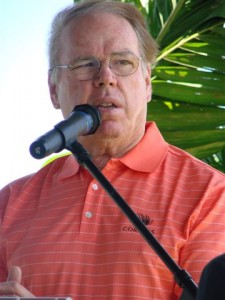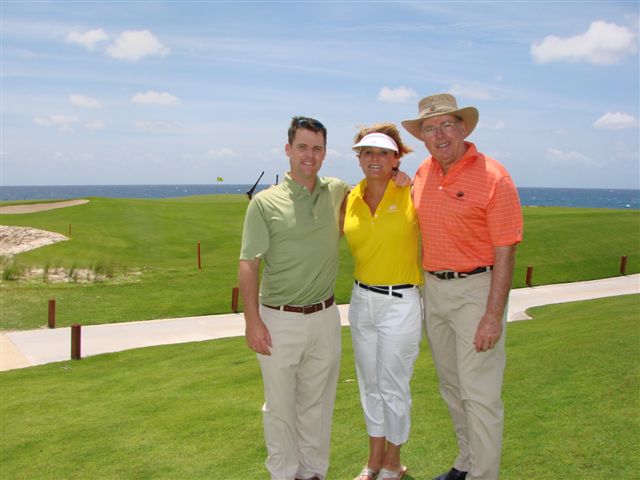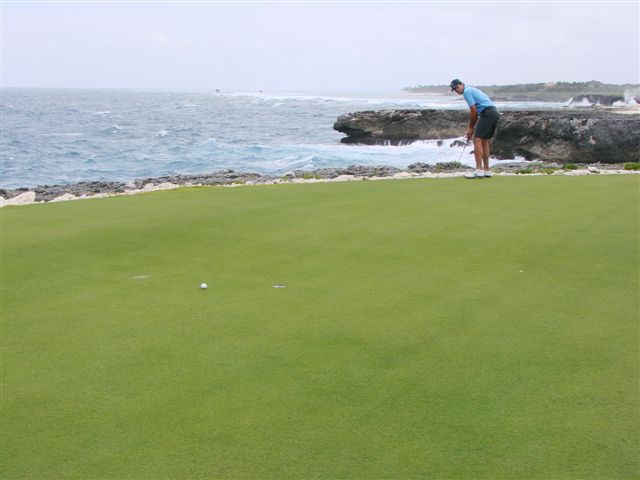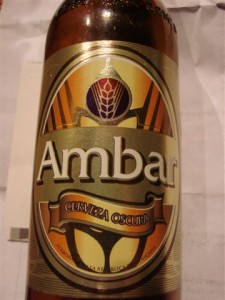 Leonel Fernández, the President of the Dominican Republic, was going to speak at the unveiling of the Corales Golf Course at the PUNTACANA Resort & Club this past April 16, but that was no problem–I was scheduled to play golf, so the choice of attire was clear.
Leonel Fernández, the President of the Dominican Republic, was going to speak at the unveiling of the Corales Golf Course at the PUNTACANA Resort & Club this past April 16, but that was no problem–I was scheduled to play golf, so the choice of attire was clear.
No, the main problem revolved around the night before–what to wear to a cocktail party at Oscar de la Renta’s house? If ever there was a chance for a disastrous fashion faux pas, this was it. The famous designer is a major investor in Corales even though he doesn’t play golf, as is singer Julio Iglesias, who does. Both live in the developing Corales neighborhood (along with that other famous golfer, Mikhail Baryshnikov) which gives access to the course, although guests at the de la Renta-designed Tortuga Bay villas and the PUNTACANA hotel can also corral some tee times.
In the end I settled on a print shirt, while Oscar went with a collarless white guayabera number. He didn’t seem too put out by my choice.
Various of de la Renta’s fashionable friends had shown up for the event (the Givenchys I was told, though I never stumbled across them), as had course designer Tom Fazio and his entourage (meaning his family), and the prime mover and shaker behind PUNTACANA, the president and CEO Frank Rainieri.
(In an editor’s nightmare, it’s always PUNTACANA, all caps, when referring to the resort, but Punta Cana when referring to the area.)
After the warm-up at Oscar’s, we all went off to the resort’s La Yola restaurant, perched right on the Caribbean Sea, where we tucked into a little snack. Those are actually giant prawns on the plate, not lobster.
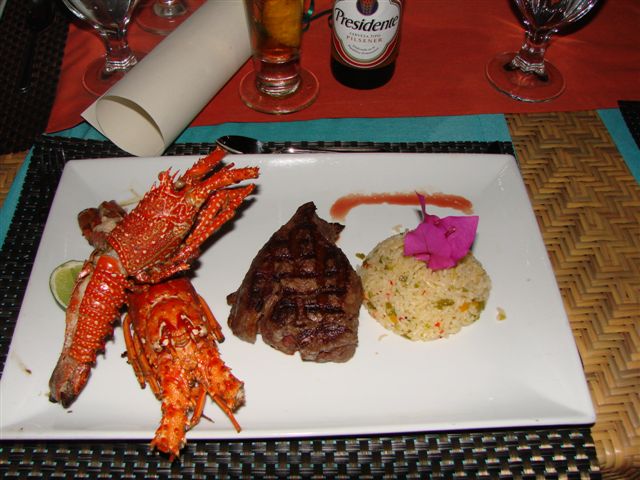
But note at the top of the photo a glimpse of a bottle of Presidente beer, and the stem of a proper pilsner glass. The Cervecería Nacional Dominicana calls its flagship beer a Cerveza Tipo Pilsener, and indeed it is a type of pilsner as all pale lagers are a type of pilsner, no matter how far removed from the appealing attributes of an actual pilsner.
Presidente is made with corn grits and sugar, and so it has much in common with any other common mass market lager, some of which are also made and marketed by the sole brewery in the country. Nonetheless, Presidente is pretty much the only beer game in town.
I had done some homework before coming down, though, and so I knew that the company had introduced a new amber beer named–in a flash of inspiration, no doubt–Ambar. My job, other than to attend and report on the Corales inauguration, was to find it. This would prove difficult.
[Now it’s impossible–see an update of sorts here on a 2011 trip to the DR.]
Less difficult perhaps, then it once was to even get to the area. The resort is celebrating its 40th anniversary, but in the beginning, said Rainieri, “This land was all bush, cactus, sea grapes, accessible only by helicopter.” Or a four-hour drive from the Santo Domingo airport to an area sparsely populated, with no infrastructure.

Dominican Republic President Leonel Fernández (left) and PUNTACANA CEO Frank Rainieri. The guy in the middle wouldn't identify himself.
It was New York labor mediator Ted Kheel and a group of investors who initially acquired about 30 square miles for $200,000, the land for what would ultimately become the 15,000-acre resort. This includes the real engine of the local economy, the Punta Cana airport, the world’s first privately-owned international airport, which extracts a fee from every visitor, and there are plenty of us.
Rainieri and local investors came on board later, and he, Kheel, de la Renta and Iglesias are now the main owners of GRUPO PUNTACANA. They look like wizards of investment as Corales debuts, a third runway is under construction at the airport, and a third golf course is also under construction, Hacienda.
P.B. Dye’s La Cana Golf Course debuted here in 2001, and P.B. (Pete Dye’s son) and his wife were so enraptured with the area that they now live here. Both attended the Corales ribbon-cutting and revealed no trace of jealously over Fazio’s work, and why should they? P.B. is designing the Hacienda course, scheduled to open late next year, although he cautioned that time was an abstract concept in the DR.
The President gave evidence of this, as he showed up about an hour late for the ceremonies. This gave me a chance to chat with Tom Fazio, who had his own perspective on time: “I don’t like to think how many courses I’ve done because it makes me feel old. I just like saying I’ve been doing this for 44 to 45 years. I still like bending over a blueprint, but I’m not as keen on the day to day stuff.”
Such details he leaves to his son, Logan, now the president of the family firm, and also in attendance with his mother, Sue. “And this will be a go-to place for my family,” said the paterfamilias during the ceremonial speeches, although he admitted to a mixed strain of feelings: “What makes a golf course great? It’s the people who are involved…the team that makes things happen…. So this is a little sad for us in a way, in that the work is over.”
The work will live on for quite awhile, as the Fazio team has created a design as fashionable as a de la Renta ensemble, with six holes skirting the Caribbean Sea, a variety of dramatic forced carries required, particularly at the home hole–which calls for the right shot over the rocky limestone coral of the Bay of Corales.
Otherwise there are broad and shapely fairways, and two holes (the third and the fifteenth) with double greens. Not shared greens, but two greens per hole. What was the thinking there?
Corales director of golf Jay Overton, who came out of what he thought was retirement after five years at Pinehurst and 32 at Innisbrook Resort, said, “What’s the number one course in the world? Pine Valley, where the eighth hole has two greens. So Frank Rainieri said to Tom, ‘If we’re going to be the number one course in the world we’d better have two holes with two greens.’ And so we do.”
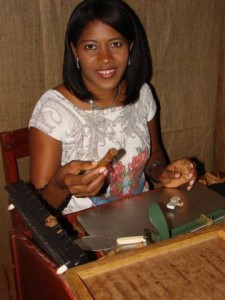
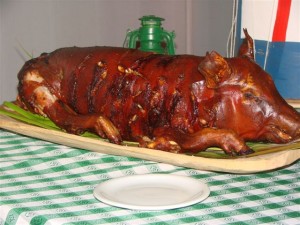 There was no Ambar beer to be found at the course, however, nor at the La Cana Clubhouse where we had dinner that night, or at the Playa Blanca restaurant on my last night. Hand-rolled cigars, yes, plenty of pork, yes, but no Ambar.
There was no Ambar beer to be found at the course, however, nor at the La Cana Clubhouse where we had dinner that night, or at the Playa Blanca restaurant on my last night. Hand-rolled cigars, yes, plenty of pork, yes, but no Ambar.
Not that that last evening was over. The Dominicans like to party, and as it was the birthday of one of Rainieri’s daughters, the feast moved on, and in a bar adjacent to where the party was being held, I made the score at last: an Ambar Cerveza Oscura, which hardly anyone among the local crowd had even heard of.
So there was a lot of show and tell about what was, all in all, more a curiosity than a brewing triumph. It’s a mildly caramel sweet beer, amber to be sure, with slightly more kick but certainly more character than Presidente.
I figured I might not pass this way again, in a number of ways, so I kept the Ambars coming. The details of the evening became a little obscura after a time, but not the pleasure of another successful beer quest.
Name: Ambar Cerveza Oscura
Brewer: Cervecería Nacional Dominicana
Style: Amber lager
ABV: 5.5%
Availability: Tough to find even in the Dominican Republic
For More Information: www.cnd.com.do
[Corales was included in a piece I did for Celebrated Living magazine, available here.]


